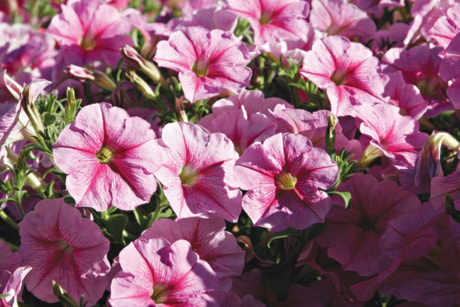When purchasing bedding-in-plants this year, you might want to think pink.
Petunias are the flower that comes to mind. They are available in many shades of pink and will spread along the ground or hang from a basket.
There is also a choice in flower size and between a single and double flower. The single flower looks better after a rain storm but the double flowers are larger and more noticeable.
Newer varieties of plants flower continually and do not need to be deadheaded.
Petunias take some frost and will thrive in full sun to partial shade.
Impatiens are available in many shades of pink. Newer varieties are compact plants that reach the height and spread of eight to 10 inches (20 to
25 cm).
These are shade loving plants that do best in baskets and containers.
They will not survive any frost.
Larkspur add linear lines to the garden and look very similar to delphiniums. Tall ones at the back of the garden help take the eye upwards while shorter varieties work well at the front.
Tall varieties of larkspur will reach four feet (3.5 metres). Dwarf varieties are less than 18 inches (44 cm) tall.
Larkspur thrive in the full sun and semi shade.
Laventera is another easy to grow plant that will reach 20 to 30 inches (50 to 75 cm) with large, showy flowers.
Laventera are not aggressive plants and do not do well when they have to compete for space and nutrients. For best results, give the plants plenty of room and plant in full sun.
Phlox are another garden staple. The shorter variety reaches four to six inches (10 to 15 cm) and belongs at the front of the border or in containers.
The plants will grow in full sun to light shade. Plants have been known to overwinter and self-seed.
Another plant for the front of the border is portulaca.
Portulaca plants are succulents that do best in hot areas with poor soil. If the plants are given rich soil, very few flowers will be produced.
Sweet peas are a plant that has been part of gardens for a few hundred years. They are grown for their flowers and perfume.
Most varieties reach five feet (1.5 metres) and need to be grown on trellises but there are a few shorter varieties available that do not need staking.
Sweet peas do best in rich soil and full sunlight. Pick often or remove dead flowers to insure the plant keeps blooming.
Snapdragons come in all sizes and shapes and are a garden staple. The newer varieties are an improvement as the plants are bushier producing more flower stems.
Snapdragons grow in full sun to partial shade. The plants will survive frost but not flower.
The fun part of these plants is the flower. If the individual flower is pressed inwards, they open like a mouth.
Geraniums can flower from the time they are set out until there is a killing frost. The plants thrive in a basket as well as in the ground.
For best results, plant in full sun.
For those who want flowers and do not want the expense and work of planting bedding-in-plants, it is possible to use seed.
Bachelor buttons, cosmos and godetia can be planted out as plants but they will also bloom from seed. It will take the flowers two to three weeks longer to mature but they will produce a spectacular show.
If the plants are allowed to go to seed, new plants will grow the next spring.
Linda Tomlinson is a horticulturalist and educator living in Rocky Mountain House. You can contact her at your_garden@hotmail.com.
